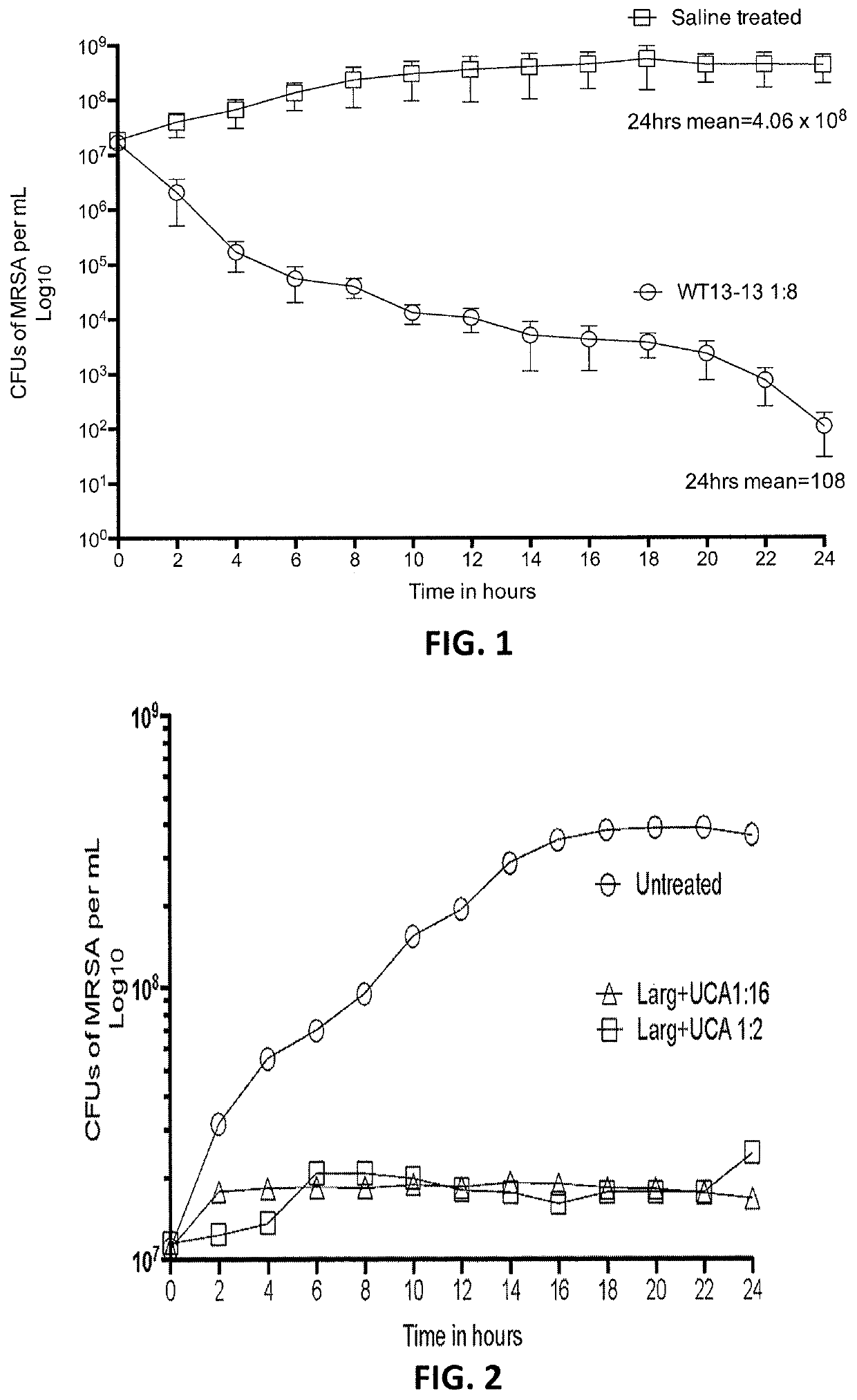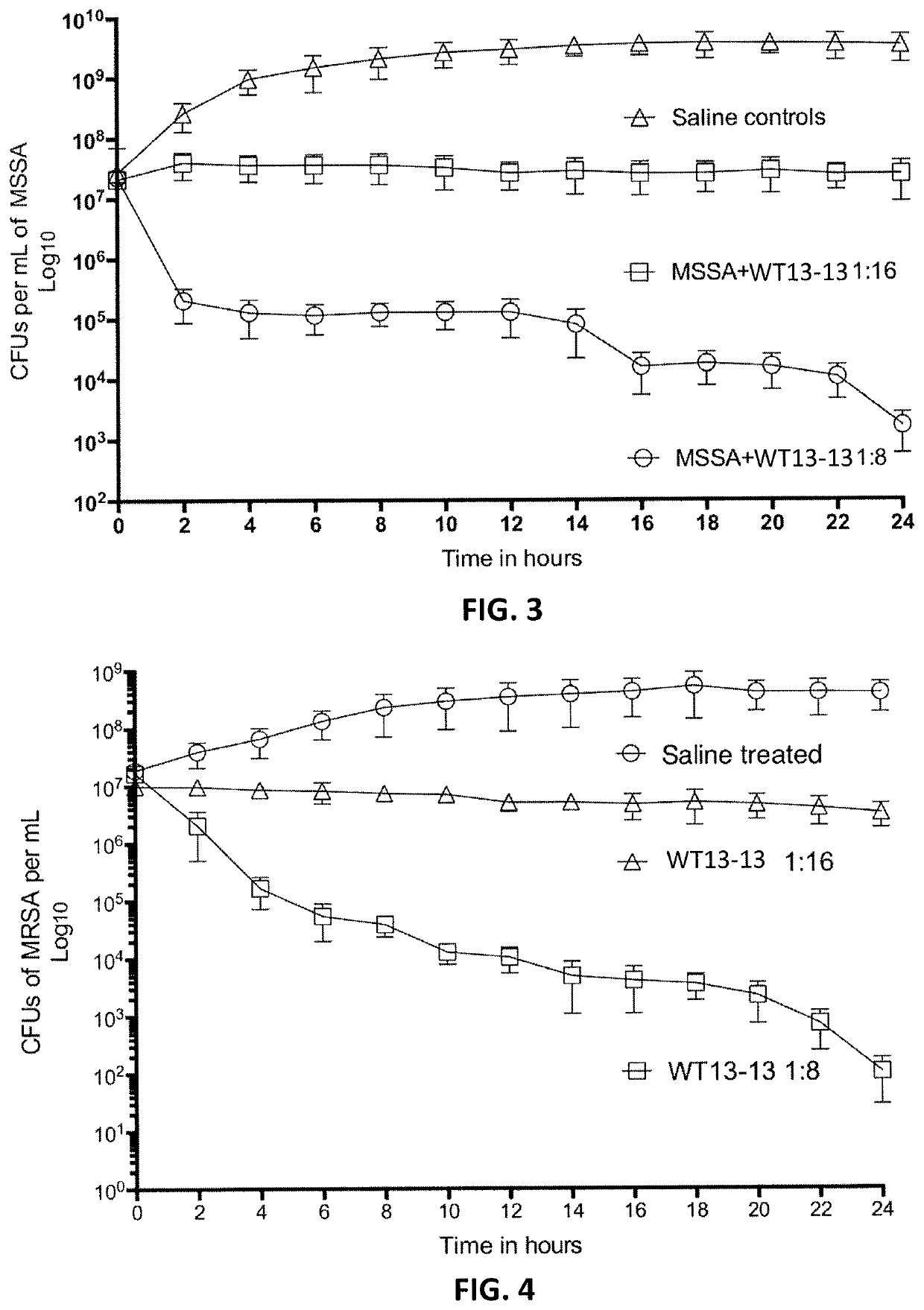Anti-pathogenic therapeutic compositions
a technology of compositions and anti-pathogens, applied in the field of anti-pathogenic therapeutic compositions, can solve the problems of increasing clinical treatment difficulties of bacterial infections of skin and underlying tissue, and increasing difficulty in treating pathogens such as bacteria, viruses or other microorganisms, and achieves the effects of facilitating powder flowability or non-stick properties, enhancing solubility, and facilitating in vitro stability
- Summary
- Abstract
- Description
- Claims
- Application Information
AI Technical Summary
Benefits of technology
Problems solved by technology
Method used
Image
Examples
example 1
reparation
[0160]One non-limiting example of an anti-pathogentic composition comprising a polar amino acid, and anthraquinone and a C11 fatty acid is described herein, and is referred to as WT13-13. This exemplary composition includes a mixture of L-Arg, cassic acid and UCA in which the mixture includes approximately 62% L-Arg, 37.6% UCA and 0.4% cassic acid. This mixture may be combined with any additive (e.g., excipient, diluent, or carrier, including water) to dilute the mixture, while retaining the relative amounts of the L-Arg, UCA and cassic acid. WT13-13 may be prepared, for example, by:
[0161]1. Add 50 g of L-arginine to 100 mL of diH2O and stir / heat at 65-85 degrees Celsius until all L-arginine goes into solution (preventing as much evaporation as possible).
[0162]2. Aliquot 100 mL of the diH2O / L-arginine solution into a separate beaker containing 25 mL of undecylenic acid (UCA) and 2.5 G of cetyl alcohol and stir and heat at 65-85 degrees Celsius until the cetyl alcohol and u...
example 3
e and Undecylenic Acid Produce a Bacteriostatic Effect but are Unable to Achieve a Bactericidal Effect in the Absence of an Anthraquinone
[0168]As shown in FIG. 2, compositions that omitted the anthraquinone (e.g., WT13-13*) were also tested, but showed bacteriostatic, but not bactericidal, effects. Using an average initial inoculum of 1.1×107 CFUs / mL of MRSA per microwell we tested four (4) clinically isolated MRSA samples. At 1:16 and a 1:2 dilution L-arginine and undecylenic acid combined together produced a non-dose dependent bacteriostatic effect that was significantly less effective than the combination of L-arginine, undecylenic acid, and cassic acid.
[0169]In contrast, anti-pathogenic composition comprising a polar amino acid, and anthraquinone and a C11 fatty acid as described herein, such as WT13-13 described above, showed strongly antibacterial effects for both gram positive and gram negative bacteria. For example, FIG. 3 is a graph illustrating the effect of two dilutions ...
PUM
| Property | Measurement | Unit |
|---|---|---|
| concentration | aaaaa | aaaaa |
| time | aaaaa | aaaaa |
| temperature | aaaaa | aaaaa |
Abstract
Description
Claims
Application Information
 Login to View More
Login to View More - R&D
- Intellectual Property
- Life Sciences
- Materials
- Tech Scout
- Unparalleled Data Quality
- Higher Quality Content
- 60% Fewer Hallucinations
Browse by: Latest US Patents, China's latest patents, Technical Efficacy Thesaurus, Application Domain, Technology Topic, Popular Technical Reports.
© 2025 PatSnap. All rights reserved.Legal|Privacy policy|Modern Slavery Act Transparency Statement|Sitemap|About US| Contact US: help@patsnap.com



